Could the days of scrounging for gas money under the seats of your car be coming to an end? Electric vehicles (EVs) are quickly becoming an economical way to travel because they’re more energy efficient than gasoline or diesel vehicles and are powered by electricity, which is typically significantly less expensive than gas.
Can you take a road trip in an electric vehicle?
The first generation of EVs had batteries with driving ranges that hovered around 100 miles. But technology advancements and economies of scale mean that most battery-propulsion systems can now travel 200 miles or more before needing to recharge. Plus, most direct current (DC) charging stations can replenish an empty EV battery to 80 percent capacity within 20 to 30 minutes—meaning longer EV road trips are becoming more attainable than ever.
Important features to look for in long-range EVs
The list of electric vehicles suitable for long-distance road trips is growing quickly, and the choices may be overwhelming for new adopters of this technology. While consumers will still need to keep in mind their budget and how they plan to use the vehicle, there are a few unique factors to consider when shopping for an electric vehicle.
Tax credits
The battery packs that power electric vehicles are more expensive than gasoline powertrains, which is why the federal government offers a federal tax credit up to $7,500—depending on the size of the battery—to help offset the higher cost of advanced alternative fuel technology.
Interested in buying an EV? Here’s where to start and what to look for
However, many manufacturers have exhausted their allotment of tax credits, and rules changed in 2022 due to the Inflation Reduction Act. The tax credit is also income-based, so not everybody will qualify for this benefit. There are some state and local incentives you can apply for to help reduce EV costs, depending on where you live.
Here are a few resources to help you navigate federal tax credit qualifications and determine if there are EV incentives within your area:
- Federal tax credits
- IRS tax code IRC 30 and 30D
- Alternative Fuels Data Center
- State and local incentives
Advertised driving range
While battery size is one factor that helps determine the driving range, it’s only the vehicle’s advertised estimates that count. Powertrain systems often reserve a small percentage of the battery that can’t be used while driving, and as a result, manufacturers have started publishing only the usable portion of the battery. Also, future software updates may be able to optimize battery usage and extend the driving range, which could increase the range further than what was advertised at the time of purchase.
Fuel efficiency
The advertised eMPG (estimated miles per gallon) was designed primarily as a cost comparison tool for consumers who are deciding between gasoline and electric vehicles, and may no longer be a useful benchmark for buyers. Fuel efficiency in electric vehicles is measured in kilowatts per hour (kWh), which is the number of miles a vehicle can travel on a kilowatt of electricity.
The weight of the vehicle, speed, topography, and wind resistance are factors that can affect a vehicle’s efficiency. However, the rule to figure out how much it will cost to power an electric vehicle is to multiply the size of the battery by the average cost the electricity utility company charges per kWh, which will vary by state and city, and whether it’s a home or public charging station.
Towing capacity
The high torque generated by electric motors makes many EVs well-suited for towing trailers, but not all electric vehicles are authorized by the manufacturer for towing and may void the warranty if any damage occurs in the process. If you plan on using the EV for towing, you’ll have to plan trips more carefully because the driving range will be reduced based on the weight of the trailer and the conditions of the roads.
Charging speed
Nearly all new electric vehicles in North America—except Teslas, which use a proprietary plug—use the standard SAE J1772 connector to charge at Level 1 and Level 2 charging stations. Level 1 chargers are cables with connectors that plug into 120-volt outlets, and Level 2 chargers use the same J1772 connector but plug into 240-volt outlets typically through an electric charging station either at home or a commercial location. Level 2 charging stations deliver electricity more than twice as fast as Level 1 chargers, but how quickly they can replenish a battery will vary depending on the specific charging station and speed of the vehicle’s onboard charger.
Level 3 chargers use direct current, rather than the alternating current (AC) used by Level 1 and Level 2 chargers. Their high amperage draw means they’re usually only installed at commercial locations, and how quickly they can recharge a battery will depend on the charging station’s voltage and the vehicle’s battery charging capability. Most new all-electric vehicles are sold with Level 3 charging capabilities that can replenish an empty battery from zero percent to 80 percent in approximately 20 to 30 minutes.
Charging station locations
Most electric vehicles will be charged at home or your workplace. However, a growing number of EV owners live in apartments or homes without access to a Level 1 or Level 2 charger and may rely on public charging stations. There are multiple networks of public charging stations, including Electrify America and EVgo, and the number of stations and locations continues to grow.
There are several apps, such as PlugShare, ChargePoint, and Roadtrippers, that can help you locate charging stations. EVs often include navigation tools that will help you plan routes with access to charging stations.
How to find EV charging stations on a road trip
Long-range EVs we love
What’s the best EV for driving long distances? The answer will vary depending on your budget and driving style, but the best EVs for road trips should be comfortable, equipped with features to help ease driver fatigue, and have more than a 200-mile range as a standard to enable you to go wherever the road takes you.
- 2023 Subaru Solterra
- 2023 Ford Mach-E
- 2023 Cadillac LYRIQ
- 2023 Hyundai IONIQ5
- 2023 Mercedes-Benz EQB
- 2023 Tesla Model Y
- 2023 Rivian R1T
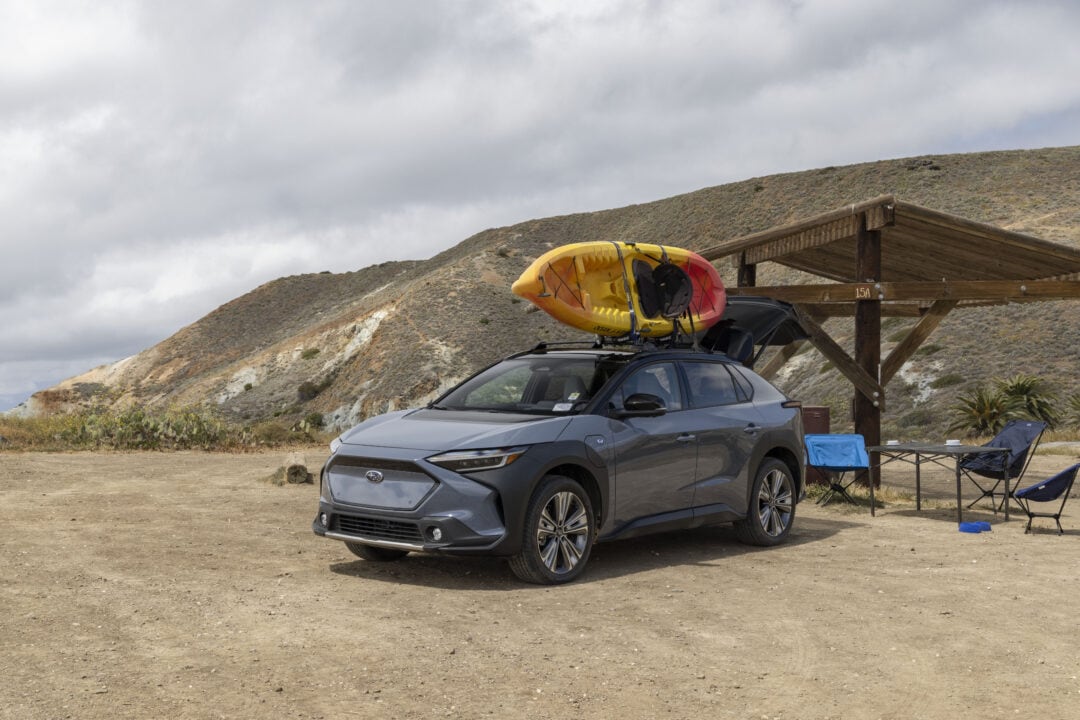
2023 Subaru Solterra
Not every road trip ends where the pavement does, which is why the 2023 Subaru Solterra is a great option for drivers who may need a vehicle that can handle a range of terrains and weather conditions. Equipped with standard all-wheel drive, the compact SUV has 8.3 inches of ground clearance and multiple drive modes to tackle difficult road conditions and give it legit adventure-ready cred. The Solterra seats up to five, and still has room for 29 cubic feet of cargo behind the second row. Roof rails with fixed cross-bar mounting points come standard for extra gear.
| SPECS | |
|---|---|
| Passengers | 5 |
| Towing capacity | N/A |
| Chassis | Unibody |
| Charge range | 228 miles |
| Type of charger | Level 1, Level 2, and DC fast charging up to 100 kilowatts per hour |
| MSRP | $44,995 |
Features and options we love:
The Solterra EV uses paddle shifters to adjust the regenerative braking and can nearly bring the vehicle to a complete stop, which makes it feel more like a rally car than your average daily driver.
More information on this vehicle can be found here.
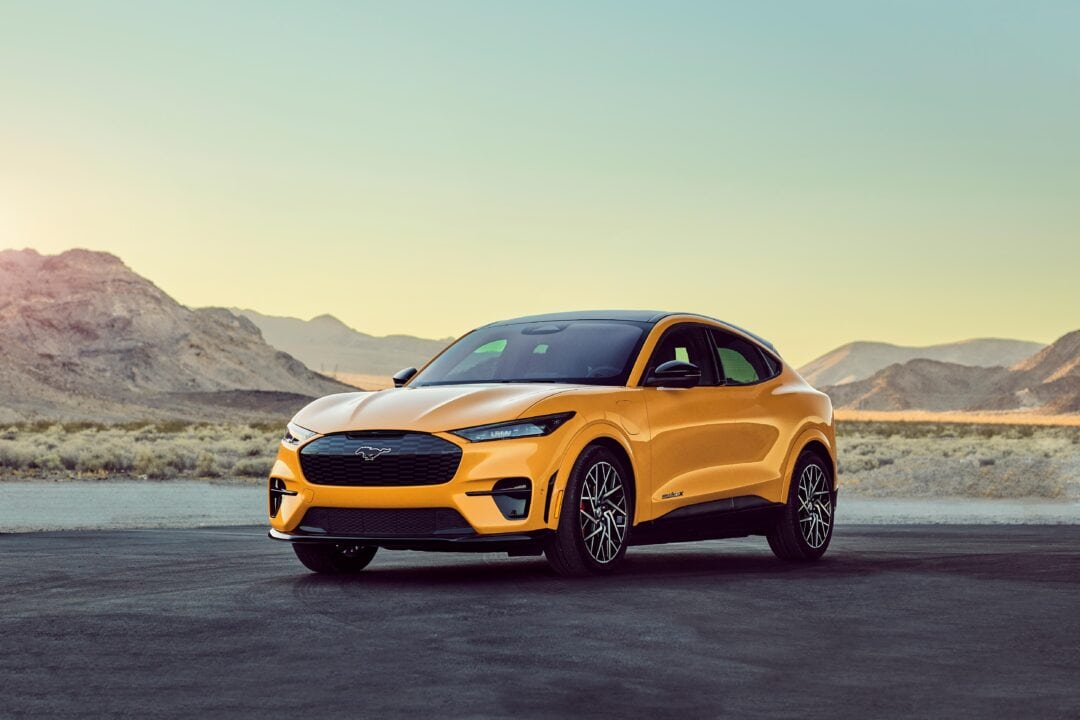
2023 Ford Mustang Mach-E
The classic American pony car has been a roadtripping favorite since its inception, and the all-electric iteration is no exception for long-distance driving. Available in Select, Premium, California Route 1, GT, and GT Performance trims, the crossover utes are equipped with electric motors with an output ranging from 266 to 480 horsepower and producing between 317 and 634 pound-feet of torque, depending on the trim. All models are equipped with standard rear-wheel drive or available all-wheel drive except the GT and GT Performance, which only use AWD to deliver a thrilling ride.
| SPECS | |
|---|---|
| Passengers | 5 |
| Towing capacity | N/A |
| Chassis | Unibody |
| Charge range | 224 to 312 miles; depending on the trim and drivetrain |
| Type of charger | Level 1, Level 2, and Level 3 DC fast charging |
| MSRP | $46,895 |
Features and options we love:
True to its heritage, the Mustang Mach-E is designed with the driver in mind. The cockpit offers up to 43.3 inches of legroom to stretch out on long drives and is also available with BlueCruise for hands-free driving under certain conditions.
The cargo area can hold 29.7 cubic feet of gear behind the second row, and 4.7 cubic feet of additional storage can be found in the front trunk. The crossover’s low ground clearance means it’s better suited for pavement than rough terrain. If speed’s your thing, the GT Performance edition can reach 60 miles per hour from a standstill in 3.5 seconds.
More information on this vehicle can be found here.
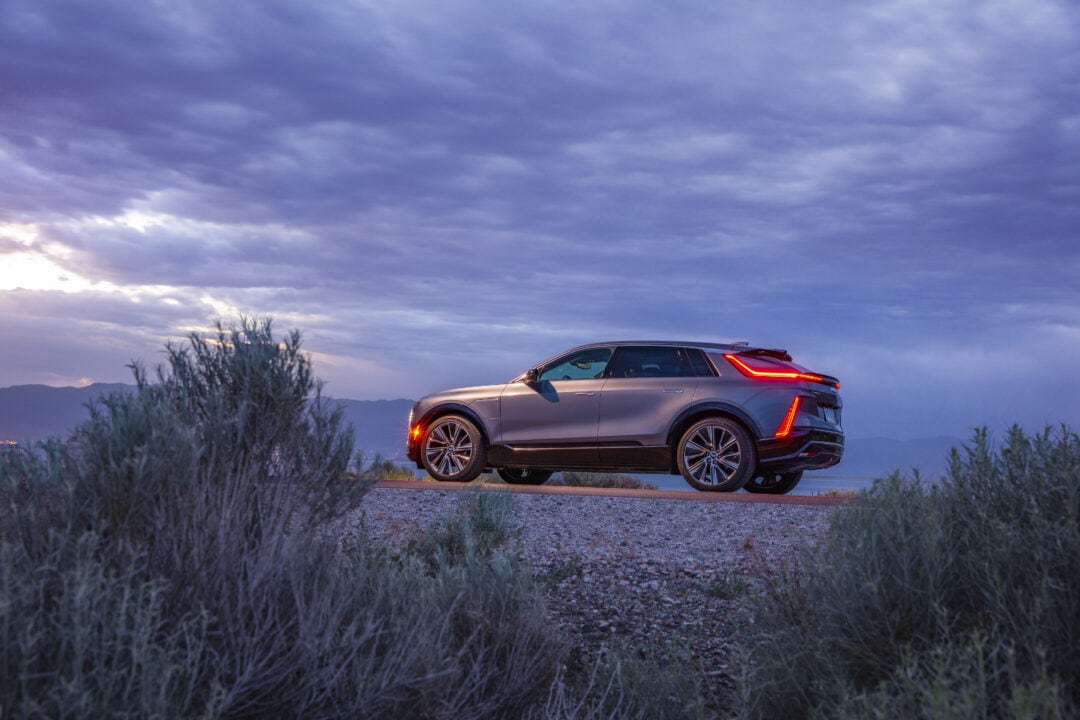
2023 Cadillac LYRIQ
With its blend of modern and heritage styling and brimming with the latest technology features, the 2023 Cadillac LYRIQ is a well-priced luxury electric crossover. The base model is equipped with standard rear-wheel drive and uses a single motor to produce up to 340 horsepower and 325 pound-feet of torque and has a 312-mile driving range.
Upgrading to the all-wheel drive variant adds a second motor that increases the output to 500 horsepower and 450 pound-feet of torque. Both feature a 33-inch digital dashboard, and while many new cars feature advanced driver assistance systems as base equipment, few go as far as Cadillac with the standard Super Cruise.
| SPECS | |
|---|---|
| Passengers | 5 |
| Towing capacity | 3,500 pounds (AWD model only) |
| Chassis | Unibody |
| Charge range | 312 miles |
| Type of charger | Level 1, Level 2, and Level 3 DC fast charging up to 190 kilowatts per hour |
| MSRP | $62,990 |
Features and options we love:
For some drivers, the massaging seats will be a must-have to help relax stiff muscles from stretches of driving. But the standard BlueCruise will help alleviate some of the mental load required for navigating along unfamiliar roads. The system uses extremely accurate lidar-mapped data and a system of cameras, radars, and sensors that enable the hands-free driving assistant to keep the vehicle centered in its lane and plan for upcoming turns and curves on more than 400,000 miles of interstate and undivided highways.
More information on this vehicle can be found here.

2023 Hyundai IONIQ 5
The Hyundai IONIQ5 is a crossover that prioritizes value and comfort, making it an ideal EV for road trips. The model is available in three trims, starting with the base rear-wheel drive SE that has a standard battery range of 220 miles and produces up to 168 horsepower. However, there’s an upgraded battery option that extends the driving range to 303 miles and increases the output to 225 horsepower, which is the same power and drivetrain that you’ll find on the mid-grade SEL and top-of-the-line Limited models.
Upgrading any of the trims with rear-wheel drive adds an electric motor to produce a maximum of 320 horsepower, but drops the range to 266 miles. The cabin is one of the roomiest in its segment, with up to 41.7 inches of legroom for the front row passengers and almost 40 inches in the second row.
| SPECS | |
|---|---|
| Passengers | 5 |
| Towing capacity | 2,300 pounds (AWD models only) |
| Chassis | Unibody |
| Charge range | 220 to 303 miles (depending on trim) |
| Type of charger | Level 1, Level 2, and Level 3 DC fast charging capacity of up to 350 kilowatts per hour on 400- to 800-volt system |
| MSRP | $41,450 |
Features and options we love:
Recharging the driver is as important as the battery on long road trips, and the IONIQ5 is the only EV to feature zero-gravity reclining front seats. Perfect to use at rest stops and charging stations, the front passenger and driver seats can recline back with footrests that extend to put the body in a neutral position and alleviate pressure after driving for hours.
More information on this vehicle can be found here.
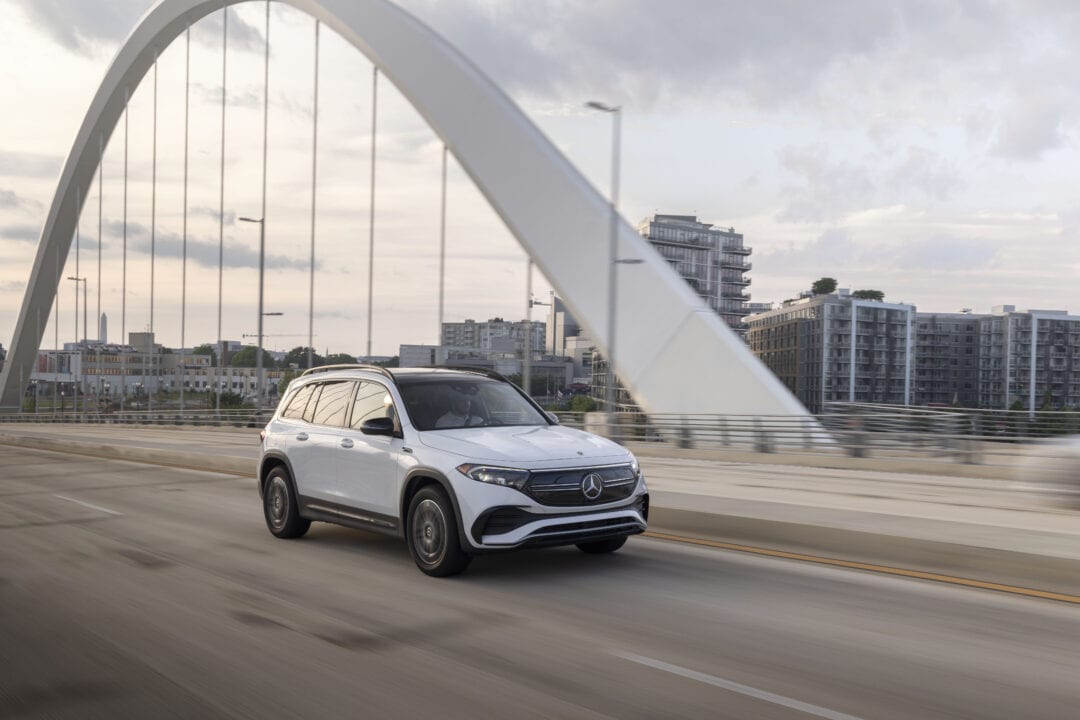
2023 Mercedes-Benz EQB
The 2023 Mercedes-Benz EQB is a roomy compact electric SUV that seats five across two rows, and it’s one of only a few electric vehicles that can be configured with an optional third row to add two seats. In addition to flexible seating, the cabin can hold up to 22 cubic feet of gear behind the second row. The upcoming entry-level EQB 250+ will offer 188 horsepower and an estimated 250-mile range on a full charge and uses front-wheel drive. The mid-grade EQB 300 adds all-wheel drive, increases power output to 225 horsepower and 288 pound-feet of torque, and a driving range of 243 miles. The premium EQB350 maxes out at 288 horsepower and 384 pound-feet of torque, but it drops the range down to 227 miles.
| SPECS | |
|---|---|
| Passengers | 5 to 7 |
| Towing capacity | N/A |
| Chassis | Unibody |
| Charge range | 227 to 250 miles |
| Type of charger | Level 1, Level 2, and Level 3 DC fast charging up to 100 kilowatts per hour |
| MSRP | $52,400 |
Features and options we love:
While many new vehicles are equipped with advanced driver assistance tech, the 2023 Mercedes-Benz EQB’s driver monitoring is particularly helpful on long drives. Its Active Emergency Stop Assist feature goes beyond automatic emergency braking, and when the semi-autonomous driving system is engaged, the system uses infrared cameras that track the drivers’ eyes to detect drowsy or distracted driving. If, after a series of alerts, the driver fails to respond to the vehicle and traffic situation, the system will bring the vehicle to a standstill in its own lane, activate the hazard lights, and attempt to alert emergency responders if it can’t contact the driver.
More information on this vehicle can be found here.
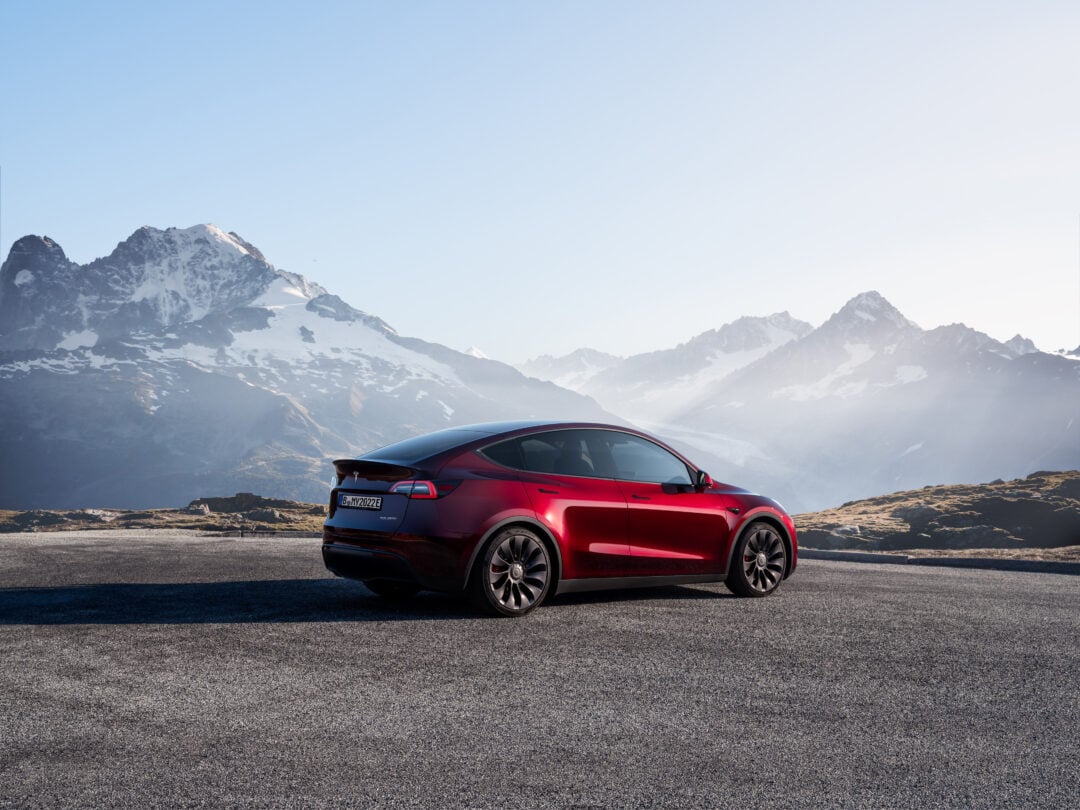
2023 Tesla Model Y
Although it launched in 2020, in many ways, the Model Y is already a classic choice for long-range EV road trips. It’s available with standard seating for five and can be ordered with an optional third row meant for occasional additional seating for children. However, the ordering options for the electric SUV can change unpredictably.
How to car camp in an EV: Tips from a Tesla Model Y owner
At present, it can only be ordered as either a Long Range model or a 303-mile Performance variant with dual motors and all-wheel drive. All Tesla models benefit from the company’s vast network of 35,000 Supercharger stations in thousands of locations.
| SPECS | |
|---|---|
| Passengers | 5 to 7 |
| Towing capacity | 3,500 pounds |
| Chassis | Unibody |
| Charge range | 303 to 330 miles (depending on model) |
| Type of charger | Level 1, Level 2, and Level 3 DC fast charging using a proprietary Tesla plug; up to 300 kilowatts per hour at Supercharger stations |
| MSRP | $65,990 |
Features and options we love:
While many Tesla fans swear by the controversial autopilot semi-autonomous system that’s often mischaracterized as full self-driving as the reason the compact crossover is a great roadtripper, it’s an expensive feature that may not be as reliable as other manufacturers’ “hands-free” technology. But the Model Y offers many features that legacy brands don’t, including “Caraoke.” The option is intended only for passenger use, but can be used by all occupants to pass the time during recharging stops. It also has a standard “Dog Mode” that can keep pets cool inside the cabin if you need to exit the vehicle for short periods of time.
More information on this vehicle can be found here.
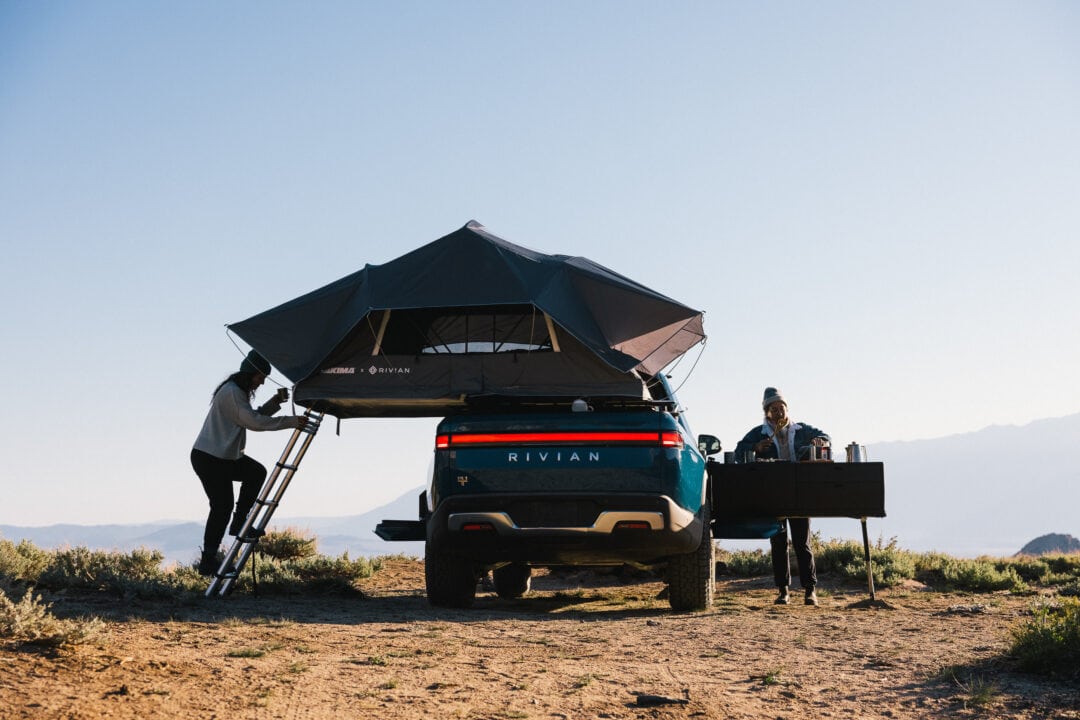
2023 Rivian R1T
The 2023 Rivian R1T is winning over early adopters of the brand’s first all-electric vehicle with its well-designed interior, thoughtful features, and ability to handle pavement and dirt with surprising agility and comfort. Equipped with standard all-wheel drive and either dual motors (one per axle) producing around 600 horsepower and 600 pound-feet of torque or quad motors (one at each wheel) that can produce more than 800 horsepower and 900 pound-feet of torque, the Rivian is designed for work and serious play.
The truck’s standard battery pack is capable of nearly 260 miles of driving distance, a large pack increases the range to nearly 320 miles, and the “Max pack” tops out at nearly 400 miles; however, how it’s driven and what it’s towing will affect mileage. Available packages and a future lineup of accessories make it easy to customize the R1T to your adventure preference.
| SPECS | |
|---|---|
| Passengers | 5 |
| Towing capacity | Up to 11,000 pounds |
| Chassis | Unibody |
| Charge range | 260 to 400 miles (depending on battery package) |
| Type of charger | Level 1, Level 2, and Level 3 DC fast charging up to 200 kilowatts per hour |
| MSRP | Starting at $73,000 |
Features and options we love:
Like Tesla, Rivian is building a planned network for Level 2 and Level 3 DC fast chargers across the U.S. Although it’s still in the early stages of the roll-out, members of the renewable-energy powered Rivian Adventure Network will have access to 6,000 DC fast chargers at 350 sites, and 10,000 Level 2 “Waypoints” will be established throughout the U.S. and Canada. This network will help support road trip-seeking drivers venturing to public parks around the U.S. Campers will also make ample use of its upcoming custom-designed camp kitchen that can be stored in the gear tunnel.
More information on this vehicle can be found here.







